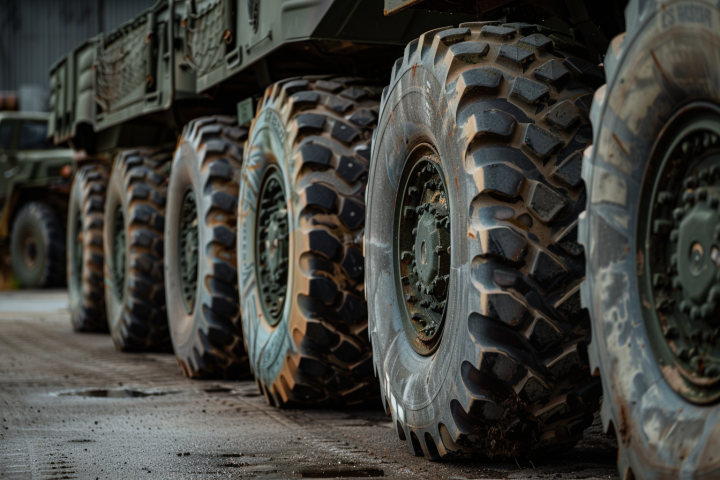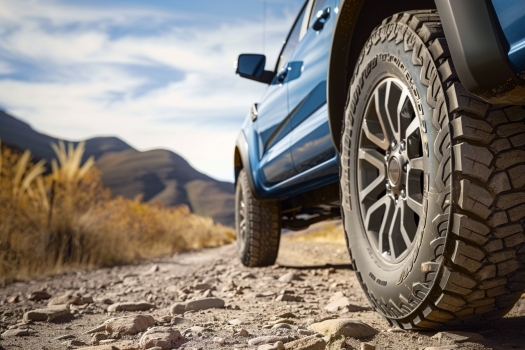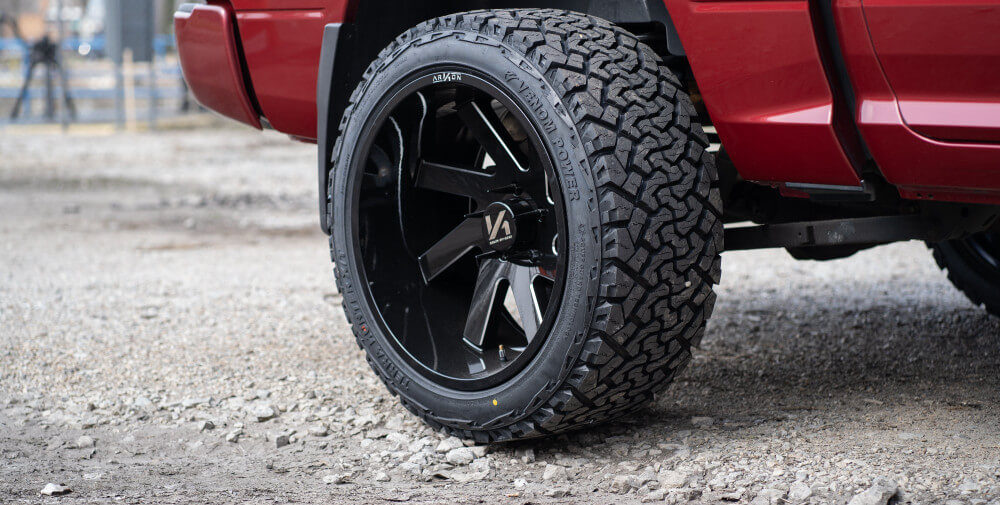Last Updated on July 26, 2025
Exploring the Durability and Design of Military Tires
Military tires are specialized components necessary for the armed forces’ operational performance. They are built to resist extreme climates and different terrains, ensuring the safety and mobility of military vehicles under challenging environments.
Overview of Tire Importance in Military Operations
In the realm of military operations, tires play an essential role that goes far beyond ordinary transportation. These are not ordinary tires; they are designed to endure some of the most challenging environments on Earth. The importance of tires in military operations is :
- Durability and Reliability: Military tires are designed to withstand extreme conditions, such as rough terrain, high temperatures, and heavy loads. Their durability is crucial for ensuring the safety and effectiveness of military personnel during operations.
- Versatility: Military tires must be able to operate in various settings, including deserts and snowy terrains. They must provide outstanding traction and stability on a wide range of surfaces.
- Mobility: Military vehicles’ mobility primarily relies on the quality of their tires. High-performance tires allow for quick and agile movements, which is vital in battle scenarios.
- Carrying Capacity: Military vehicles usually transport large equipment, supplies, and soldiers. Tires must be able to withstand these enormous loads while maintaining performance.
- Stealth Operations: To prevent discovery, some missions require tires to be as quiet as possible. This requirement has resulted in the development of tires that produce less noise when in motion.
Criteria for Selecting Military Tires
When choosing tires for military usage, several primary factors must be examined to ensure they fulfill the demands of military operations:
- Terrain Compatibility: The tires should be appropriate for the terrain in which they will be used. This contains issues for dirt, sand, rock, snow, and urban areas.
- Load Capacity: Tires must have a high load capacity to support the weight of military vehicles and cargo.
- Damage Resistance: Given the challenging conditions of many military operations, tires must be durable against punctures, cuts, and other types of damage. This frequently includes strengthened sidewalls and distinctive tread patterns.
- Maintenance Requirements: Military tires should require less maintenance. This includes a longer lifespan and the ability to function in many situations without frequent maintenance or replacement.
- Adaptability: In some cases, tires must adapt to different vehicles and equipment. This flexibility is essential in operations with limited resources.
- Environmental Considerations: Military operations often take place in sensitive environments. Therefore, tires should be designed to reduce environmental impact, including reduced noise levels and lower emissions.
- Cost-Effectiveness: While performance is important, cost reduction must also be considered. The military must balance the cost of tires with their performance and lifespan.

Historical Evolution of Military Tires
The historical evolution of military tires shows a journey of innovation and adaptation. From the early days of solid rubber designs to today’s advanced, long-lasting tires, these tires have evolved to fulfill the demanding needs of military operations.
From World Wars to Modern-Day
- World War I and II Era: The early 20th century marked the beginning of moveable vehicles during the war, which replaced horse-drawn carriages. During World War I, tires were crude, often composed of solid rubber, with little traction and comfort. By World War II, the role of motor vehicles in military strategy increased significantly, necessitating advances in tire technology. Pneumatic (air-filled) tires became the standard, improving shock absorption and handling.
- Post-World War Developments: The post-war period saw necessary tire materials and design advances. One significant development was the introduction of synthetic rubber due to the reduction of natural rubber. These synthetic rubbers were more durable and better suited for different terrains.
- Vietnam War Era: The Vietnam War brought challenges with its bad terrain and tropical climate. This led to the development of tires capable of handling mud and jungle conditions, using deeper treads and more robust sidewalls.
- Late 20th Century to Modern Day: The late 20th century saw better improvements by introducing radial tire technology, which offered improved durability and fuel efficiency. Today, military tires are highly specialized and designed to meet the specific needs of modern warfare, including urban environments and desert conditions. Run-flat technology and airless tires are recent innovations that enhance safety and reliability.
Technological Advancements in Tire Design
Several vital technological advancements have marked the evolution of military tires:
- Synthetic Rubber: The shift from natural to synthetic rubber was essential. Synthetic rubber tires provide better results in harsh temperatures and are more robust to wear and tear.
- Radial tires: With their parallel ply arrangement, they offer superior traction, fuel efficiency, and longevity than conventional bias-ply versions.
- Run-flat technology enables vehicles to continue operating even after a tire has sustained significant damage. This is important in battle settings, as a blown tire might mean the difference between life and death.
- Airless Tires: Also known as non-pneumatic tires, these are being developed to reduce the possibility of punctures. They are helpful in challenging fighting situations when regular tires can be damaged easily.
- Advanced Tread Patterns: Modern military tires feature advanced tread designs that enhance mobility in diverse terrains, including mud, sand, and snow. These patterns are also designed to self-clean, shedding debris that could impede traction.
- Environmental Considerations: Recent designs focus on reducing the environmental impact of tires. This includes using eco-friendly materials and designing tires that offer better fuel efficiency.
- Smart Tire Technologies: An emerging trend is using sensors and other technologies to monitor tire conditions in real-time. This can provide valuable data on tire health, improving maintenance and operational readiness.
Types of Tires Used by the U.S. Military
The U.S. military employs several tire types to ensure its vehicles are prepared for the different and challenging conditions they face. These range from all-terrain tires for general use to specialized tires designed for armored cars and extreme conditions.
All-Terrain Tires
- Versatility and Durability: All-terrain tires are designed to perform well in various conditions, including on and off-road environments. Their flexibility makes them the go-to choice for many regular military vehicles. These tires often include a tread design that balances the need for traction on loose conditions like mud and sand with stability and quiet operation on solid highways.
- Design Features: Key design features of all-terrain military tires include reinforced sidewalls to withstand punctures and tears, deeper tread depths for improved grip, and rubber compounds that can withstand extreme temperatures and rough surfaces.
- Applications: They are commonly used on light to medium-weight vehicles, such as troop transport vehicles, light trucks, and reconnaissance vehicles.
Armored Vehicle Tires
“The Unsung Heroes of Defense Machinery” is a blog that delves into the crucial role that tires play in the functionality and reliability of armored vehicles. Tires, while often overshadowed by the more visible aspects of these military behemoths, play an essential role in assuring agility, longevity, and safety in rugged terrain. This blog discusses the technological advancements, design considerations, and rigorous testing that armored vehicle tires undergo, emphasizing their role in modern military operations.
- Enhanced Protection and Load-Bearing Capacity: Tires for armored vehicles are specifically designed to handle the additional weight and provide the necessary protection against threats like shrapnel and small arms fire. These tires are often much larger and more robust than standard all-terrain tires.
- Run-Flat Technology: Run-flat technology is an essential feature in armored vehicle tires. It enables the vehicle to move at a reduced speed even after the tire has been severely damaged, which is necessary for maintaining mobility in combat situations.
- Customized Design: The tread patterns and rubber compounds are often customized for the specific operational needs of the vehicle, ensuring maximum traction and stability under the heavy loads and high-stress conditions typical of armored vehicles.
Specialized Tires for Extreme Conditions
Specialized Tires for Extreme Conditions explores the world of high-performance tires designed to overcome the most challenging environments. From hot deserts to frozen tundras, these tires are designed to ensure safety, efficiency, and unparalleled performance under extreme conditions. We will delve into the innovative technologies and materials used in crafting tires that can withstand everything nature throws them, providing a critical edge in various demanding scenarios.
- Designed for Specific Environments: These tires are developed for environments with harsh challenges, such as deep snow, ice, desert sands, or mountainous terrain. They are often used in specialized vehicles designed for these conditions.
- Advanced Materials and Technology: These tires may use improved materials and technology, such as non-pneumatic structures or unique tread compounds, to provide stability and traction in environments where conventional tires would fail.
- Custom Tread Patterns: The tread patterns for these tires are highly specialized. For example, tires designed for snowy and icy conditions have more profound, strong tread patterns for better grip. Desert tires may be more thorough to resist sinking into the sand and have a tread design that aids in sand removal.
Leading Manufacturers of Military Tires
Only a few companies flourish in the specialist business of manufacturing military tires. These businesses supply tires that keep military vehicles moving while also contributing to the improvement of tire technology through constant innovation.
Profiles of Top Manufacturers
Several companies stand out in the field of military tire manufacturing, each with its history and area of knowledge:
- Michelin: A renowned name in tire manufacturing, Michelin has a long history of supplying tires for military vehicles. Known for its innovative radial tire technology, Michelin offers a range of tires that cater to various military needs, from light tactical vehicles to heavy-duty armored trucks.
- Goodyear: Another leading tire manufacturer, Goodyear, has been a long-time supplier of military tires. They are known for their robust and durable tires, which are suitable for various military applications. Goodyear’s military tires are designed to perform in extreme conditions and are often used on heavy vehicles.
- Bridgestone: Bridgestone, a global leader in tire manufacturing, also supplies high-quality tires for military use. Their products are praised for high performance and reliability under challenging conditions. Bridgestone’s commitment to research and development has made it a key player in the military tire market.
- Continental AG: Continental is known for producing a wide range of automotive parts, including tires for military vehicles. Their military tires are designed to offer high traction, durability, and resistance to extreme conditions, making them suitable for various military applications.
Innovation in Military Tire Manufacturing
Military operations’ unique and demanding requirements drive innovation in military tire manufacturing. Some of the critical areas of innovation include:
- Run-Flat Technology: This technology allows military vehicles to continue operating even with severely damaged tires, which is vital for safety and tactical advantages in combat zones.
- Advanced Rubber Compounds: Developing new rubber compounds that can withstand harsh temperatures and rough terrain has been a significant area of innovation. These compounds extend the life of tires and enhance their performance in challenging environments.
- Airless Tire Technology: Some manufacturers produce airless tires, which promise to prevent punctures and reduce maintenance needs. These tires are beneficial in harsh combat environments where traditional tires are more prone to damage.
- Eco-Friendly Technologies: With growing environmental concerns, manufacturers also focus on eco-friendly technologies in tire production. This includes using sustainable materials and production processes that minimize environmental impact.
- Sensor Integration: Combining sensors into tires to monitor conditions like pressure and temperature is an emerging trend. These sensors can provide valuable data for predictive maintenance and ensure operational readiness.
Performance and Durability Testing
The performance and durability of military tires are essential to the safety and effectiveness of military operations. Therefore, rigorous testing methods and standards are in place to ensure these tires meet the highest demands of military use.
Testing Methods and Standards
Military tires undergo stringent tests designed to simulate the harsh conditions they will face in real-world scenarios. Military standards and industry best practices guide these tests.
- Laboratory Testing: In the lab, tires are tested for various physical properties, including strength, flexibility, and resistance to wear and tear. Tests might involve exposing tires to extreme temperatures, U.V. radiation, and various chemicals to assess their durability under different environmental conditions.
- Field Testing: Field tests involve installing the tires on military vehicles and subjecting them to real-world operational conditions. This includes driving on different terrains, such as mud, sand, rocky surfaces, and paved roads, to evaluate the tires’ traction, stability, and handling characteristics.
- Load-Carrying Capacity: Tests are conducted to ensure the tires can handle the weight of heavily loaded military vehicles without performance degradation. This includes loading the tire for long and unique tests with the car in motion.
- Speed and Agility Tests: Tires are tested for their performance at high speeds and during rapid turning, which is needed for tactical operations.
- Puncture and Damage Resistance: Tires are tested to copy battlefield situations, including impacts from sharp objects, shrapnel, and ballistic threats.
- Standards Compliance: Military tires must adhere to specific military standards, which specify the minimum performance criteria they must achieve. These requirements assure consistency and dependability across multiple manufacturers and tire batches.
Case Studies of Tires in Action
Checking real-world case studies provides valuable insights into the performance and reliability of military tires under operational conditions.
- Conflict Zones: Tires used in recent military wars have been subjected to harsh conditions, including improvised explosive devices (IEDs) and rough terrain. Reviews of these situations often highlight the durability of modern military tires, especially those equipped with run-flat technology.
- Humanitarian Missions: Military tires have also been tested in humanitarian missions, where they must overcome challenging terrains to deliver aid. These missions have demonstrated the tires’ load-carrying capacity and durability capabilities.
- Extreme Weather Operations: Operations in harsh weather conditions, such as deserts or arctic environments, test the tires’ ability to withstand extreme temperatures and challenging surfaces. The performance of tires in such conditions helps refine their design for specific environmental challenges.
Environmental and Operational Considerations
Military operations require the highest level of equipment performance, adaptability to a wide range of weather conditions, and a growing focus on efficiency. In terms of tire production, this translates into various approaches to design and manufacturing.
Adapting to Different Climates and Terrains
The different climates and terrains where military operations occur need tires that can perform reliably under various conditions.
- Climate Adaptability: Military tires must perform well in high heat, freezing weather, and everything in between. This requires using materials and designs that preserve their properties throughout a wide temperature range.
- Terrain problems: Each terrain, from the sandy dunes of the desert to the muddy fields of temperate zones, provides its problems. Tires built for desert operations, for example, are often broader to avoid sinking into the sand and have unique tread patterns for improved traction. On the other hand, tires designed for snowy or icy conditions require deeper treads and, in some cases, metal studs or chains for added traction.
- Air Pressure Adjustment Systems: Some military vehicles are equipped with systems that allow on-the-fly tire air pressure adjustment. This feature enables the car to adapt to different terrains by changing the tire’s footprint to ensure proper traction and load distribution.
Sustainability Efforts in Tire Production
The environmental impact of tire production is a growing concern, leading to sustainability efforts in the industry.
- Eco-Friendly Materials: The shift towards more sustainable materials in tire manufacturing is evident. This includes the use of recycled materials and the development of new, more environmentally friendly rubber compounds.
- Reducing Carbon Footprint: Efforts are being made to reduce the carbon footprint of tire production. This involves proper manufacturing processes for energy efficiency, reducing waste, and improving the overall lifecycle impact of tires.
- Longevity and Recycling: Increasing tire longevity directly contributes to environmental sustainability by reducing the frequency of tire replacement and, consequently, waste. Developing more efficient recycling processes for military tires also ensures the materials are reused or disposed of responsibly.
- Research and Development: Ongoing research into alternative materials, such as bio-based rubbers and advanced synthetic compounds, promises to reduce the environmental impact of military tires further. Collaborations between tire manufacturers and ecological research institutions drive these innovations.
The Future of Military Tires
The future of military tires is shaping up to be an exciting fusion of cutting-edge technology and innovative design, driven by the evolving needs of modern warfare and environmental considerations.
Emerging Technologies and Trends
Several emerging technologies and trends are set to redefine the landscape of military tire manufacturing:
- Airless Tires: Airless, or non-pneumatic, tires are gaining traction as a promising technology for military use. These tires are immune to punctures and blowouts, providing an apparent tactical advantage in hostile environments. Their unique design offers high durability and can be tailored to various terrains.
- Intelligent Tire Systems: Integrating sensor technology within tires is an emerging trend. These sensors can monitor air pressure, temperature, and tire integrity in real-time, allowing for proactive maintenance and enhanced safety.
- Advanced Materials: Research into new materials, including advanced rubber composites and reinforced fibers, aims to produce tires that are lighter, more durable, and adaptable to more extreme conditions. Using sustainable materials also aligns with the growing emphasis on environmental responsibility.
- 3D Printing: The potential use of 3D printing in tire production is being explored. This technology could allow for rapid prototyping and manufacturing of tires with complex designs and customized features.
- Self-Healing Materials: Research into self-healing rubber compounds could lead to tires that can repair minor cuts and punctures, vastly extending their operational lifespan and reliability.
Predictions for the Next Generation of Tires
Looking ahead, the next generation of military tires is expected to feature several advancements:
- Increased Automation in Manufacturing: Automation in tire production is likely to increase, leading to higher precision in manufacturing and the ability to produce tires with complex, mission-specific designs more efficiently.
- Greater Specialization: As military operations become more specialized, tires will follow suit, with specific designs for different types of vehicles and missions. This includes tires tailored for urban warfare, uncrewed cars, and specialized reconnaissance missions.
- Enhanced Durability and Performance: With advances in materials science and tire design, future military tires are expected to offer even more excellent durability and performance, capable of handling more extreme conditions and heavier loads.
- Eco-Friendly Production: The trend towards environmentally friendly production processes and materials will continue. This includes greater use of recycled materials, biodegradable components, and manufacturing processes with reduced carbon footprints.
- Adaptation to Emerging Vehicle Technologies: As military vehicles evolve, incorporating electric drivetrains and autonomous technologies, tires will be developed to match these advancements, potentially including features like improved energy efficiency and compatibility with autonomous navigation systems.
Case Studies and Real-world Applications
Military tires play a crucial role in various operations and missions. Their performance can be a determining factor in the success of these endeavors. This article delves into notable missions, highlighting the importance of tires in military operations, and shares insights from military vehicle operators on their experiences with these essential components.
Notable Missions and the Role of Tires
Several missions in recent history underscore the significance of high-quality military tires:
- Desert Operations: In operations like those in the Middle East, tires face extreme heat and abrasive terrains. For instance, in the Iraq and Afghanistan conflicts, military vehicles often traveled on rough, unpaved roads and over harsh desert landscapes. The durability of tires in these conditions was vital for maintaining supply lines and ensuring mobility for combat and reconnaissance missions.
- Jungle Warfare: Operations in jungle environments, like those in parts of Southeast Asia, present a different set of challenges, including wet, muddy, and uneven terrain. Tire performance in these conditions was critical for the maneuverability and effectiveness of military vehicles.
- Peacekeeping Missions: In peacekeeping missions in regions like the Balkans and parts of Africa, military tires had to navigate various terrains, from rural landscapes to urban environments. The tires’ adaptability in these diverse conditions ensured that peacekeeping forces could move quickly and respond effectively to multiple situations.
- Humanitarian Assistance: During humanitarian missions, such as disaster relief operations, the reliability of military tires is crucial in ensuring that aid reaches affected areas. These missions often involve traveling over debris-laden roads and damaged infrastructure, requiring tires that can withstand these challenging conditions.
Interviews with Military Vehicle Operators
Insights from military vehicle operators provide a firsthand perspective on the importance of tires in their operations:
- Durability and Reliability: Operators often discuss the importance of tire durability, noting that reliable tires are crucial for avoiding breakdowns and ensuring safety in hostile environments.
- Performance in Extreme Conditions: Many operators highlight how the right tires have enabled them to navigate challenging terrains, from deep mud to rocky paths. The confidence in their vehicle’s ability to handle such conditions is often attributed to the quality of the tires.
- Run-Flat Technology: Operators frequently mention the benefits of run-flat technology, particularly in combat zones, where the ability to keep moving after a tire has been damaged can be life-saving.
- Maintenance and Longevity: Ease of maintenance and tire longevity are also common themes. Operators appreciate tires that require minimal maintenance and can last longer under challenging conditions.
- Adaptability: Another point of appreciation is the ability to adapt tires for different vehicles and missions. This flexibility allows for more efficient use of resources, especially in remote or resource-limited environments.
Maintenance and Lifecycle Management
Proper maintenance and lifecycle management are essential for ensuring military tires’ long and high performance. Implementing best practices for tire maintenance and having effective strategies for lifecycle analysis and replacement is necessary for the optimal functioning of military vehicles.
Best Practices for Tire Maintenance
Effective tire maintenance is critical to maximizing the performance and extending the life of military tires. Some of the best practices include:
- Regular Inspections: Routine checks for cuts, punctures, and irregular wear patterns are crucial. This includes examining the tires for any damage that might have occurred during operations.
- Pressure Checks: Correct tire pressure is essential for optimal tire performance. Overinflated or underinflated tires can lead to uneven wear, reduced traction, and increased susceptibility to damage.
- Rotation and Balancing: Regular tire rotation and balancing help in even wear distribution. This practice is essential for military vehicles that carry heavy loads or operate in rugged terrains.
- Alignment Checks: Proper alignment ensures even tire wear and improves vehicle handling. Misalignment can lead to premature tire wear and reduce the effectiveness of the vehicle.
- Cleanliness: Tires must be kept clean from oils, fuel, and other substances that can degrade rubber. Regular cleaning also allows for more thorough inspections.
- Storage Conditions: Tires should be stored properly to prevent damage when not in use. This includes keeping them away from direct sunlight, ozone, and harsh temperatures, which can degrade the rubber.
Life Cycle Analysis and Replacement Strategies
Understanding the lifecycle of military tires and having strategies for their replacement is essential to tire management.
- Wear and Tear Monitoring: Regular monitoring of tire wear helps determine its lifespan. This involves measuring tread depth and looking for signs of aging or damage.
- Usage Records: Keeping detailed records of tire usage, including the types of missions they have been used for and the terrains they have encountered, helps predict their lifespan and plan for replacement.
- Performance Analysis: Analyzing the performance of tires over their life cycle provides insights into when they should be replaced. This analysis can be based on factors like traction, fuel efficiency, and the ability to handle loads.
- Replacement Criteria: Establishing clear criteria for tire replacement is crucial. This includes setting tread depth thresholds and identifying performance issues that indicate a tire is no longer fit.
- Recycling and Disposal: Proper disposal and recycling of old tires are part of responsible lifecycle management. Environmental regulations should dispose of military tires, and recycling options should be explored to minimize waste.
Conclusion & Recommendations
The exploration into the world of military tires has revealed several key aspects necessary to military operations. The robustness, versatility, and technological advancements in military tires underscore their critical role in the success and safety of military missions. Key findings include:
- Tire Types: The military uses a wide range of tires, including all-terrain, armored vehicle tires, and specialist tires for harsh circumstances, each tailored to fulfill unique operating requirements. Run-flat technologies, airless tires, and intelligent tire systems are all examples of technological innovations transforming military tire capabilities.
- Leading Manufacturers: Leading manufacturers such as Michelin, Goodyear, and Bridgestone are essential in producing high-quality, durable military tires.
- Stringent Testing Standards: Military tires undergo performance and durability testing to guarantee that they meet the standards of military operations.
- Environmental and Operational Considerations: Environmental and operational considerations include adapting to varied climates and terrains and introducing sustainable methods into tire manufacture.
- The Future of Military Tires: New technology and trends point to increasing efficiency, specialization, and sustainability in military tire production.
Implications for the Future of Military Logistics
The advancements and trends in military tires have significant implications for the future of military logistics:
- Enhanced Operational Efficiency: Improved tire technologies lead to increased efficiency in military operations, with vehicles capable of handling more challenging environments and conditions.
- Sustainability in Logistics: The shift towards eco-friendly tire production aligns with broader military environmental responsibility goals, indicating a more sustainable approach in future logistics.
- Adaptability and Readiness: The ability of military tires to adapt to various operational scenarios enhances the overall readiness and versatility of military forces.
- Future Innovation and Development: The ongoing change in tire technology shows that military logistics will continue to benefit from innovative solutions, enhancing the effectiveness and safety of military personnel.
Why choose Tires Easy?
In light of these insights into military tires, it’s clear that the choice of tires, whether for military or civilian use, is of paramount importance. Tires Easy offers a vast selection of high-quality tires for those inspired by the level of detail and innovation found in military tires and seeking similar qualities in tires for personal or commercial use.
At Tires Easy, you can find many tires that incorporate the same principles of durability, adaptability, and performance essential in military tires. Whether navigating rough terrains or looking for reliable tires for everyday use, our selection caters to all your needs.
Explore Our Collection and Find the Perfect Tires for Your Vehicle Today
– Your journey to superior performance and safety on the road begins with a click!
FAQs
Who makes tires for the U.S. military?
Leading tire manufacturers such as Michelin, Goodyear, and Bridgestone produce tires for the U.S. military. These companies specialize in creating durable and reliable tires that meet the rigorous demands of military operations.
Does the military use bulletproof tires?
The military uses tires with run-flat technology, which allows vehicles to continue moving even after sustaining significant damage. Although not yearly, these tires are designed to be highly resistant to punctures and other forms of damage.
Does the military use airless tires?
The military has been exploring the use of airless tires for their vehicles. These non-pneumatic tires offer advantages such as eliminating punctures, increased durability, and reduced maintenance, making them suitable for challenging military environments.
Are military tires any good?
Military tires are highly regarded for their durability, reliability, and performance in extreme conditions. They are specifically engineered to handle the demanding requirements of military vehicles in various terrains and climates.
What tires wear most?
In general, tires that are used on rough terrains and under heavy loads tend to wear the most. Tires in deserts or mountains often face quicker wear in military applications due to harsh environmental factors.
What kind of tires do the military use?
The military uses different tires, including all-terrain, run-flat, and specialized tires designed for harsh conditions. The choice depends on the vehicle type and the operational environment.
What size tire is on a 5-ton military truck?
A typical 5-ton military truck, like the M939 series, often uses around 11.00R20 or 14.00R20 tires. Large, rugged tires are designed to support vehicles’ vehicles’ and demanding use.
-
Automotive Specialist
-
Proofreader
-
Writer












